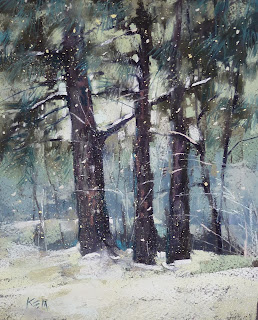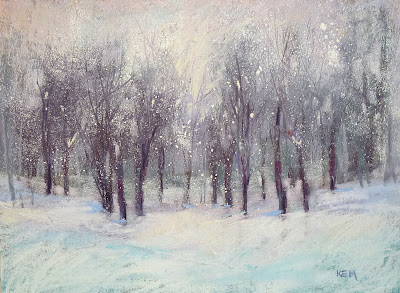 |
| 'Beneath the Setting Sun' 18x24 pastel ©Karen Margulis |
This was one of my favorite paintings of 2o17. Not only did I thoroughly enjoy painting it. I was honored for it to be awarded Best in Show at the 2017 Southeastern Pastel Society Exhibition! Enjoy the following post from the archives:
We need the darks. A light shines brighter when it is surrounded by dark. When I want to create the illusion of light...the intense glow of sunset...I know I need to surround the light with strong darks. Pastel paintings are traditionally done by layering the darker values first. I embrace these darks and love starting a painting with a rich dark pastel. But I don't want to use any dark color and I never use a black pastel for my darks (I do have an exception to this which I will share later this week)
I love to use COLORFUL DARKS in my paintings.
I consider a colorful dark to be a very dark value that may be close to black but just a darker value of a color. In my pastel collection I always like to have a a dark version of each color on the color wheel. I love to use
Terry Ludwig dark pastels. You can get a great collection in his dark sets.
I also like using
Diane Townsend soft form pastels. I usually purchase these open stock. I consider a dark blue, green, purple and red must have pastels! See photos of my dark pastels below.
 |
| The underpainting with texture applied |
Today's painting is a good example of the power of rich and colorful darks. This scene demanded rich darks to allow light of the setting sun to look bright enough. I used a variety of darks to build up the dark and shadowed area of the painting. I began the painting with a dark underpainting using Art Graf blocks and water. I applied some gesso and pumice mix to build up the texture of the grasses in the meadow.
In the photo below you can see the layers of dark. I like to build up the dark areas with several sticks of color that are all the same value. If you look closely you can see that there is one dark eggplant color that is a bit darker. This is the famous Terry Ludwig Eggplant pastel. It is a must-have pastel but I reserve it for accents only.
 |
| Layering those colorful darks |
With pastel we start with the darks and build up layers and gradually get lighter. This allows for a strong base on which to build the lights and the details. It is much easier to tone down a dark area than to try to introduce it in an area that is too light. That is a sure recipe for mud. Start dark and rich with colorful darks!
 |
| close up detail |
Painting Note: This is an 18x24 version of one of my favorite paintings from last year. I wanted to challenge myself to size up form the original 9x12 painting. It was great fun to let the texture of the ground suggest the texture of the grass! I used Uart paper.


















































